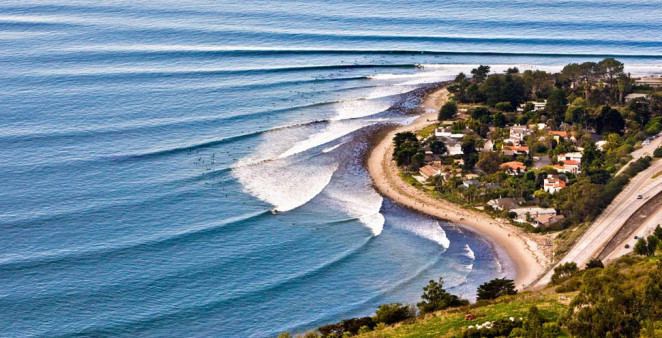 | ||
Similar Carpinteria State Beach, Emma Wood State Beach, Carpinteria Bluffs Nature Pr, Refugio State Beach, Leadbetter Beach | ||
Rincon (Spanish, "angle" or "corner") is a surf spot located at the Ventura and Santa Barbara County line in Southern California, USA. Also known as the "Queen of the Coast", Rincon is one of the most famous surf spots in California, known around the world for its well-formed waves and long rides. The book 100 Best Surf Spots in the World rates Rincon at 24. It is best at low tide during the winter months when swells are coming mostly from the west and northwest. There is a gated residential community that occupies most of the Rincon beachfront. However, public access is provided at parking lots on both sides of the gated community, with restrooms and a picnic area in the upper parking lot, Rincon Beach Park.
Contents
Rincon Point is home to the Rincon Classic surf championship scheduled for January each year. The championship draws local surf greats and spectators to the beach every year. Though scheduled for January, the event is often delayed until surf conditions merit a contest. The Rincon Classic is open to area residents only.
Rincon is referenced in The Beach Boys classic song from 1962, Surfin' Safari:
At Huntington and Malibu
They're shooting the pier
At Rincon they're walking the nose
We're going on safari to the islands this year
So if you're coming get ready to go
Location
Rincon is located along U.S. Route 101 at Bates Road.
Rincon is divided into three parts: the Cove, Rivermouth, and Indicator. The cove is the best part of the point and is the closest to the freeway. Rivermouth is the fastest section of the wave reaching from the mouth of Rincon Creek to the large white/stone house. Tube rides occur mainly at Rivermouth at low tide. Indicator is at the top of the point, visually obstructed from the freeway. While Rincon is most famous for its long right-breaking waves, Indicator also produces some extremely fast left-breaking waves during the summer, when southerly swells are most prevalent. During a larger westerly swell, all three sections often connect into one contiguous ridable wave.
Because of the quality of the wave, people travel from all over the world to surf there, sometimes resulting in extremely crowded surfing conditions, but rarely in aggressive behavior, physical altercations or injuries.
There have been occasional deaths at Rincon, mostly resulting from surfers getting caught at the bottom of the cove at higher tides during larger swells and getting smashed into the granite boulders which support the nearby freeway.
Environmentally, Rincon Creek has a tendency to flow higher levels of bacteria into the surf zone during heavy rains, resulting in occasional beach closures.
History
In 1769, the Spanish Portola expedition came west along the beach from the previous night's encampment at Pitas Point. The explorers found a large native village at a watering place near the mouth what is now called "Rincon Creek", and camped nearby on August 16. Fray Juan Crespi, a Franciscan missionary travelling with the expedition, noted that "As soon as we arrived all the people came to visit us, and brought us a great supply of roasted fish to eat" The 1775 (second) expedition led by Juan Bautista de Anza camped at the same place, referring to the native village as "La Rinconada".
In 1835, the area was included in a 4,460-acre (18.0 km2) land grant called Rancho El Rincon. The grant extended along the coast on both sides of the Santa Barbara/Ventura county line, and encompassed present-day Rincon Point, Rincon State Beach and La Conchita.
